From our resource library for organizational scheduling and management.
10 Best Employee Scheduling Apps to Streamline Your Workforce

Taking the Headache Out of Scheduling: A Quick Look at the Top Apps
Managing employee schedules can feel overwhelming - just mention it to managers across restaurants, retail, healthcare, emergency services, or military operations and watch them sigh. Many still struggle with outdated spreadsheets, endless phone tag, and scheduling conflicts that drain time and energy. Effective scheduling goes beyond just filling shifts - it's about optimizing your workforce, maintaining proper coverage, controlling overtime costs, and supporting work-life balance.
The challenge of coordinating workers has existed since the start of organized labor. From factory time clocks to today's complex 24/7 operations, managers face the same core question: how do you get the right people working at the right times? While early solutions relied on manual processes, modern scheduling tools have made huge strides. The best systems share three essential qualities - they're simple to use, flexible enough to adapt, and accessible to everyone who needs them. Good scheduling software streamlines communication, handles repetitive tasks automatically, and lets employees manage their own availability.
In this guide, we'll explore 10 top scheduling apps that solve these common headaches. Whether you oversee a team of first responders, coordinate nursing staff rotations, or manage construction crews across job sites, you'll learn the key features and trade-offs of each platform. We'll help you find the right solution to make scheduling easier and win back your time. Let's look at the tools that are changing how smart managers handle staff scheduling.
1. Acroroster
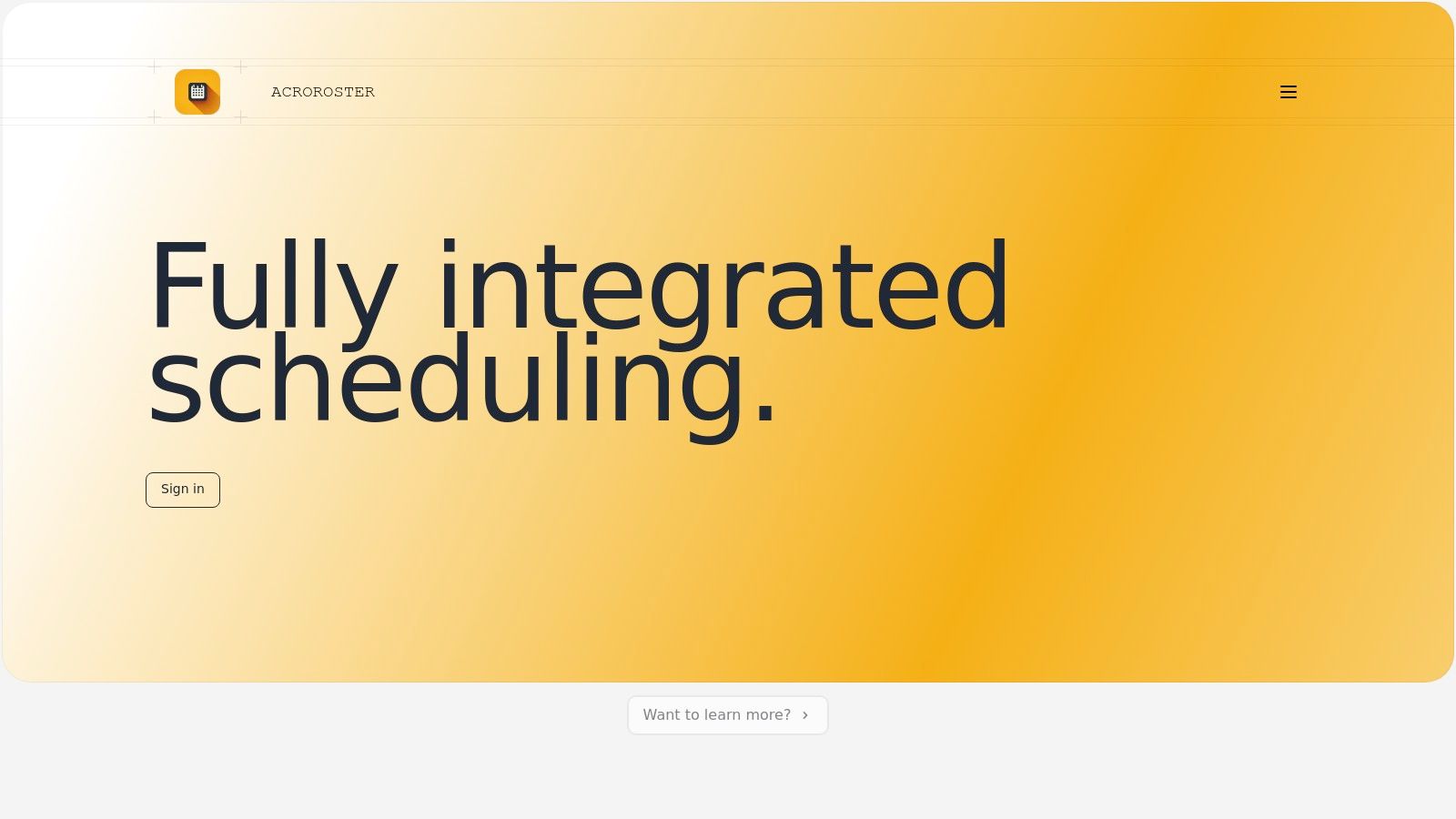
Acroroster is a solid cloud-based scheduling platform built for organizations with demanding staffing needs. It's especially useful for 24/7 operations that need to manage rotating shifts and complex staff schedules, such as first responders, healthcare facilities, and military units. The platform brings together scheduling, shift management, and staff availability tracking in one central system.
Consider a fire department managing multiple crews across different shifts while accounting for firefighter certifications, time-off requests, and emergency coverage. With Acroroster, they can handle all these moving parts from one place. Hospitals use it to coordinate nurses, doctors and support staff schedules across departments. Even retail businesses with multiple locations find it helpful for staff scheduling.
Key Features and Benefits:
- Cloud Platform Access: Manage schedules from any device with internet connectivity for real-time updates and better team communication
- Smart Scheduling Tools: Create rosters quickly, assign shifts efficiently, and track staff availability in one place
- Enterprise Integration: Full support team and ability to connect with your existing systems and databases
- Specialized Design: Built specifically for emergency services, healthcare, law enforcement and other demanding scheduling environments
Pros:
- Complete cloud-based system that makes scheduling easier
- Strong enterprise support and database connectivity
- Perfect for organizations with complex scheduling demands
- Makes tracking staff availability straightforward
Cons:
- No public pricing - you must contact sales for costs
- Feature-rich platform may take time to learn and master
Setup Tips:
Plan to work closely with Acroroster's team during setup to customize the system for your needs. Before starting, map out your current scheduling process and identify the biggest pain points you want to solve. Get key team members involved in training to ensure smooth adoption.
How It Compares:
While many scheduling tools exist, Acroroster stands out by focusing on industries where precise scheduling is mission-critical. Unlike basic scheduling apps, it offers specialized features for sectors where scheduling mistakes could have serious consequences.
Website: https://acroroster.com
Though pricing isn't public, Acroroster's robust capabilities and dedicated support make it worth exploring for organizations dealing with complex staff scheduling. The next step is contacting their sales team for a demo and quote to evaluate if it fits your needs.
2. When I Work
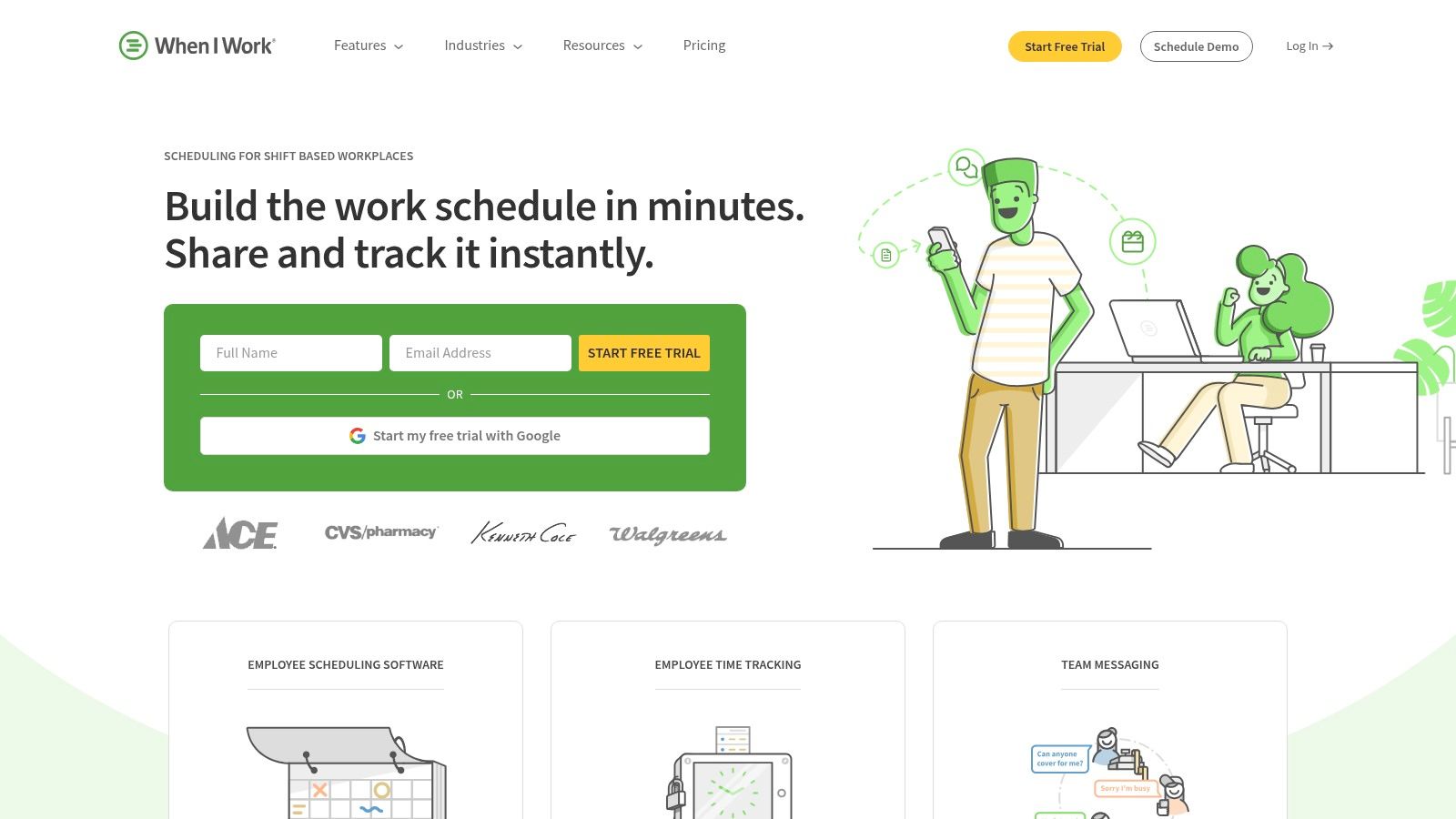
When I Work helps businesses manage employee schedules and time tracking through simple but powerful software. The platform works great for many industries - from first responders and healthcare to restaurants and retail. Whether you're scheduling police officers, nurses, or servers, When I Work gives you one central place to handle it all.
The schedule builder uses an easy drag-and-drop system that anyone can master quickly. Making changes takes seconds - just drag shifts around to swap them or quickly fill empty spots with available staff. This speed and simplicity really helps in fast-moving environments where schedules change often.
Staff can clock in and out right from their phones using the mobile app with GPS tracking. This eliminates paper timesheets and buddy punching while making sure people are actually at their work sites. The GPS verification is especially useful for businesses with employees at multiple locations, like security firms or construction companies. Plus, the automatic time tracking feeds directly into payroll.
The built-in messaging keeps everyone in sync. Managers can instantly share updates about shift changes, new policies, or upcoming training. For fields like healthcare where clear communication is critical, these messaging tools are essential. Staff can also manage their own schedules - requesting time off, trading shifts, and updating when they're available to work. This self-service approach saves managers time while giving employees more control.
Pros:
- Clean, simple interface that's quick to learn
- Full-featured mobile app for scheduling and timekeeping on the go
- Strong team communication tools built right in
Cons:
- Basic plan has limited reporting capabilities
- Higher pricing for bigger teams since cost is per employee
While prices aren't listed publicly, you can request a personalized quote based on your needs. Since it's cloud-based, you just need a web browser or the mobile app to use it.
Among scheduling tools, When I Work shines for its straightforward design and mobile features. Though some competitors offer deeper reporting, When I Work hits the sweet spot of powerful but uncomplicated.
Implementation Tip: Before rolling out When I Work, map out your current scheduling workflow. This helps identify where the software can simplify things. Get your team using the mobile app early on - it's key for smooth adoption.
For more scheduling software options, check out The Ultimate Guide to Employee Scheduling Applications. When I Work makes this list thanks to how well it balances features, ease of use and mobile access. Visit When I Work to learn more and schedule a demo.
3. Deputy
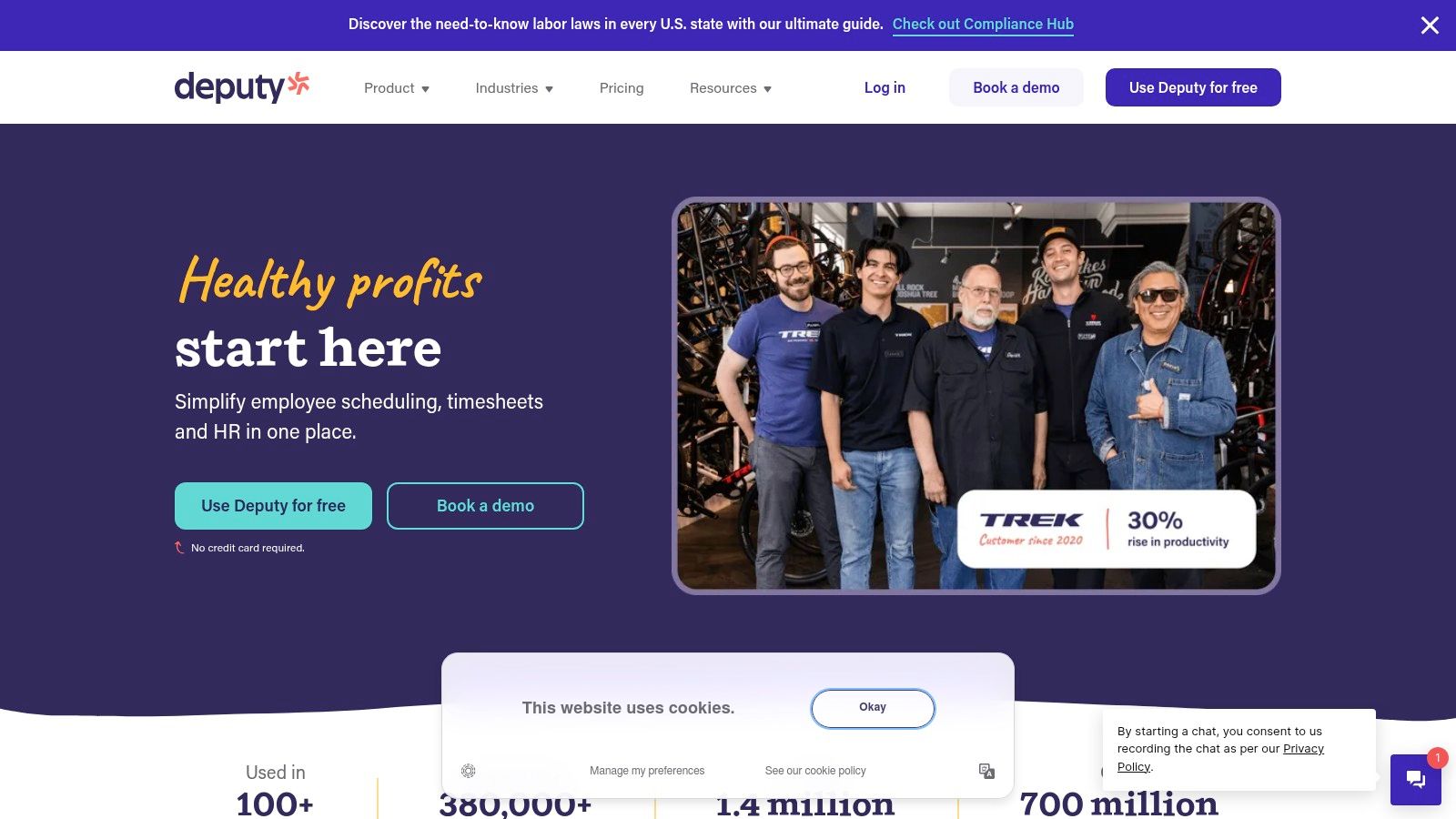
Deputy helps businesses manage their workforce effectively, with features designed for industries like first response, healthcare, restaurants, retail, manufacturing, construction and security services. The platform combines scheduling, time tracking, task management and team communication tools to help optimize operations and maintain compliance.
Key Features and Benefits:
- Smart Scheduling: Create schedules automatically based on rules, availability and demand. This saves significant time for businesses dealing with changing staffing needs, like restaurants handling seasonal rushes or first responders ensuring 24/7 coverage.
- Cost Management: Track labor costs in real-time and adjust schedules to prevent overstaffing and excess overtime. Especially useful for managing tight profit margins in retail and food service.
- Compliance Tools: Stay on top of labor laws, breaks, overtime rules and certifications tracking. Critical for healthcare, security and other regulated industries to avoid penalties.
- Task and Performance: Manage projects, track progress and monitor employee performance. Construction teams can oversee project timelines while security services can coordinate patrol routes.
- Team Updates: Built-in messaging keeps everyone connected for smooth shift changes and emergency coordination. Essential for first responders and healthcare workers who need instant communication.
- System Integration: Works with common payroll, POS and HR platforms to reduce manual data entry and errors.
Pros:
- Top-notch compliance features: Ideal for highly regulated industries
- Extensive integration options: Connects smoothly with existing systems
- Detailed reporting: Provides clear workforce insights
Cons:
- Takes time to learn: More complex than basic scheduling tools
- Premium pricing: May exceed small business budgets
Pricing:
Contact Deputy's sales team for custom pricing based on features and employee count.
Technical Requirements:
Access via web browser or mobile apps for iOS and Android.
Implementation Tips:
- Train thoroughly: Make sure staff knows how to use all key features
- Configure properly: Adjust settings for your specific needs
- Use analytics: Review reports regularly to spot trends and issues
Comparison:
Deputy offers more capabilities than basic scheduling apps, making it better suited for larger organizations needing robust workforce management. While similar to When I Work and Homebase, Deputy stands out with advanced compliance tools and reporting - especially valuable for regulated industries and larger teams.
Website: Deputy.com
4. 7shifts

7shifts stands out as a focused scheduling solution built specifically for restaurants. While designed primarily for food service, its scheduling tools work well for other businesses like retail and security services that deal with similar staff management challenges. The platform helps managers optimize staffing costs and keep teams connected - essential for busy service environments.
The software goes beyond basic scheduling with restaurant-specific capabilities. Managers can assign server sections, track required breaks, and adjust staffing based on projected sales volume. This targeted approach helps create efficient schedules that balance labor costs and service quality. Built-in messaging tools let staff easily swap shifts, update availability, and stay informed through team announcements.
A major advantage is how 7shifts connects with popular restaurant POS systems. This integration enables scheduling decisions based on actual sales data and helps forecast labor costs accurately. While 7shifts doesn't publish pricing openly, they offer different plan levels to match various business needs. You can check plan options and request quotes on their website.
Features:
- Restaurant scheduling tools (section assignments, break tracking)
- Labor cost management
- Staff communication tools
- POS system integration
Pros:
- Features designed for restaurants
- Works well with restaurant POS systems
- Good value for the cost
Cons:
- Limited use outside restaurants
- Premium features need higher-tier plans
Implementation Tips:
- Document your current scheduling process first to identify key needs
- Use 7shifts' training resources to get your team up to speed
- Connect your POS system early to optimize labor costs
While 7shifts works best for restaurants, other businesses can benefit from its core scheduling and communication features. Retail stores might find the sales-based scheduling helpful, while security companies could use the team communication tools. However, if you need more than basic scheduling, consider a broader workforce management system.
For more insights, check out our guide: Restaurant Employee Scheduling Software: The Ultimate Guide to Transforming Workforce Management
Learn more at 7shifts' website
5. Homebase
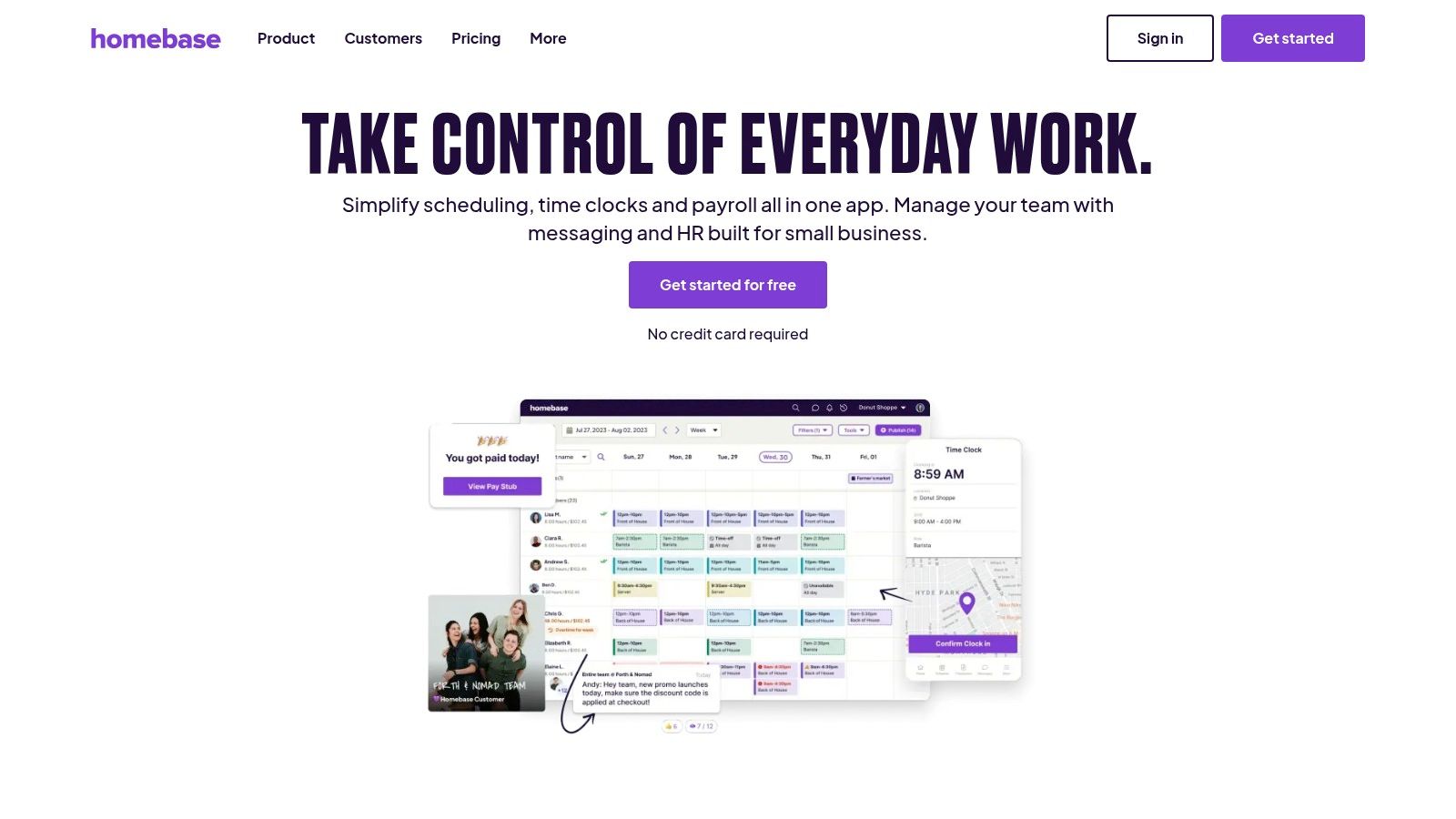
Homebase is an employee management platform that makes running a small business much simpler. The system works great for various industries, from restaurants and retail to healthcare and first responders. It handles all the basics - scheduling, time tracking, and HR tasks - in one easy-to-use package. Small businesses with a single location can get started with the free plan.
Need to create schedules for your restaurant staff while handling shift swaps and time-off requests? Homebase makes it simple. Managing a security team? The system tracks guard hours and includes GPS clock-in features to verify locations. Even healthcare facilities benefit from the straightforward interface when coordinating complex staff schedules.
Key Features for Different Industries:
- Free basic scheduling: Perfect for small teams that need simple, reliable scheduling tools
- Employee hiring and onboarding: Makes paperwork and training easier for new hires across retail, restaurants, and security services
- Time clock with photo verification: Essential for construction and security to prevent buddy punching and maintain accurate records
- Labor cost tracking: Helps restaurants and manufacturing track expenses in real-time for better staffing decisions
Pros:
- Free plan for single locations: Great way for small businesses to start without any costs
- Simple, clear interface: Minimal learning curve means quick adoption, especially helpful in fast-paced environments
- Built-in HR tools: Makes handling paperwork and onboarding easier for businesses without HR departments
Cons:
- Limited customization: While easy to use, may not handle very specific scheduling needs
- Premium features cost extra: Features like detailed reports and GPS tracking require paid plans
Pricing: Basic features are free for one location. Paid plans offer more features like advanced reporting and payroll integration. Visit their website for current pricing.
Technical Needs: Works through web browsers and mobile apps (iOS/Android) so staff can access it anywhere.
Setup Tips:
- Test the free version first to see if it fits your needs
- Use the training materials during initial setup
- Get feedback from your team to improve how you use the system
Website: https://joinhomebase.com
Small businesses will find great value in Homebase, especially with the free tier. While some advanced features need a subscription, the free version offers solid scheduling and time tracking tools that work well across many industries. The system stands out for its ease of use and ability to handle core workforce management tasks efficiently.
6. Humanity
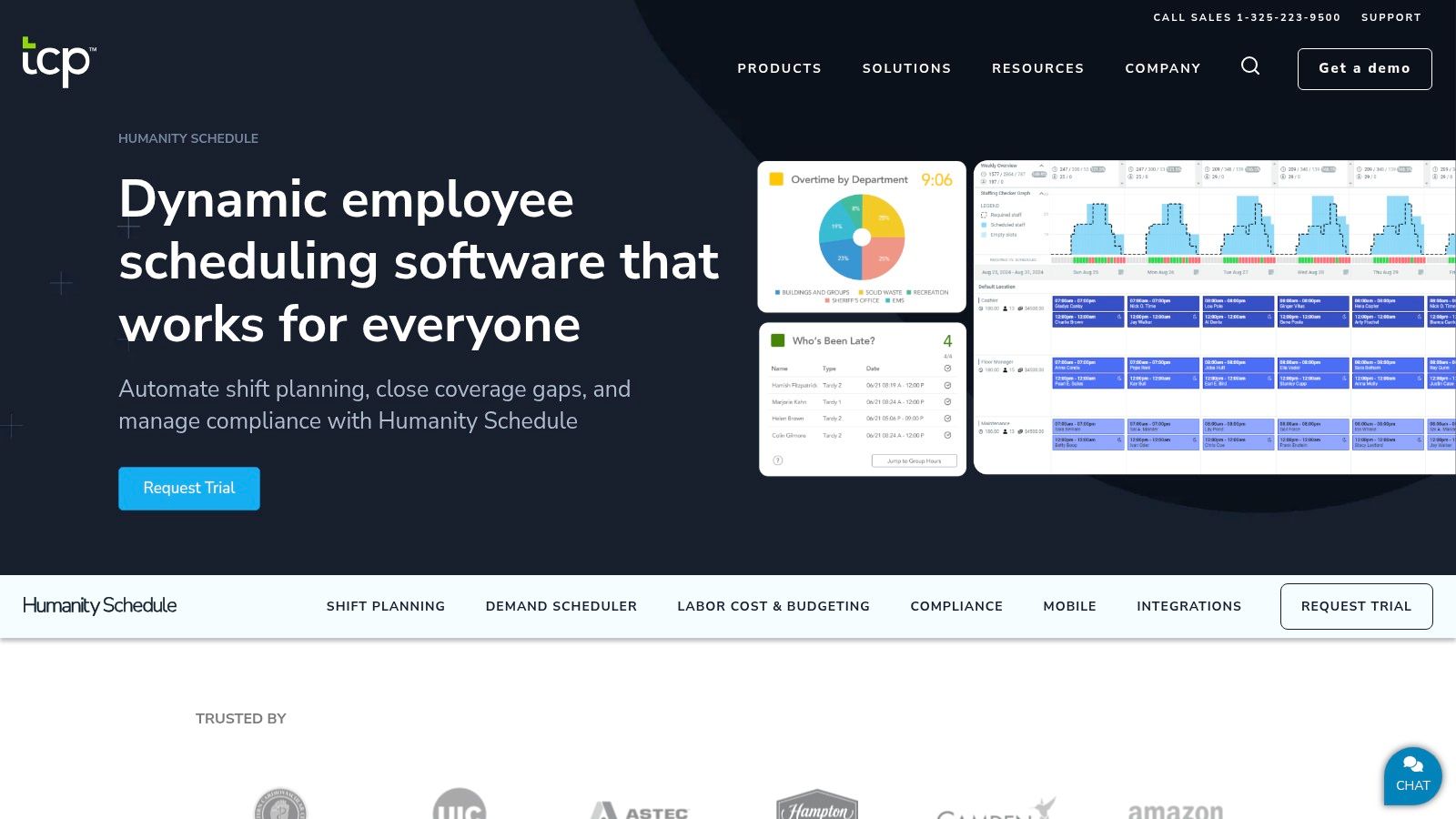
Humanity makes it easier for large organizations to manage complex employee scheduling needs. The software works especially well for 24/7 operations like healthcare facilities, first responder services, and other businesses with demanding staffing requirements. Its standout features include smart automation tools, detailed reporting capabilities, and certification tracking.
Consider how a fire station needs to maintain minimum staffing levels while juggling vacations, training sessions, and required certifications. Humanity helps managers track all these moving parts and automatically fill shifts based on qualifications and availability. In healthcare settings, it simplifies scheduling for nurses, doctors and support staff across departments. The system also helps retail, manufacturing and security companies match staffing to changing demand patterns.
Key Features:
- AI-powered scheduling: Creates schedules automatically using rules, availability data and demand forecasts
- Skills tracking: Monitors employee certifications and qualifications to ensure properly staffed shifts
- Leave management: Centralizes time-off requests and approvals while maintaining coverage
- Custom reports: Analyzes labor costs, overtime, attendance and other key metrics
Pros:
- Strong automation: Reduces manual scheduling work
- Integration options: Works with payroll, HR and other systems
- Detailed analytics: Provides actionable workforce insights
Cons:
- Higher cost: May be too expensive for small businesses
- Complex setup: Initial configuration takes time and technical expertise
Pricing: Contact sales team for custom quotes based on organization size and needs
Technical Requirements: Access via web browser and mobile apps
Implementation Tips:
- Train thoroughly: Ensure all users know how to use key features
- Document scheduling rules: Define requirements clearly for automated scheduling
- Review reports regularly: Use data to optimize staffing practices
Tool Comparison: While similar to When I Work and Deputy, Humanity offers more advanced forecasting and automation features suited for larger organizations with complex needs.
Website: https://www.humanity.com
For large enterprises in demanding industries that need robust scheduling capabilities, Humanity delivers strong value despite its higher price point and setup complexity. The software excels at managing diverse workforces while providing useful data insights.
7. Calendly
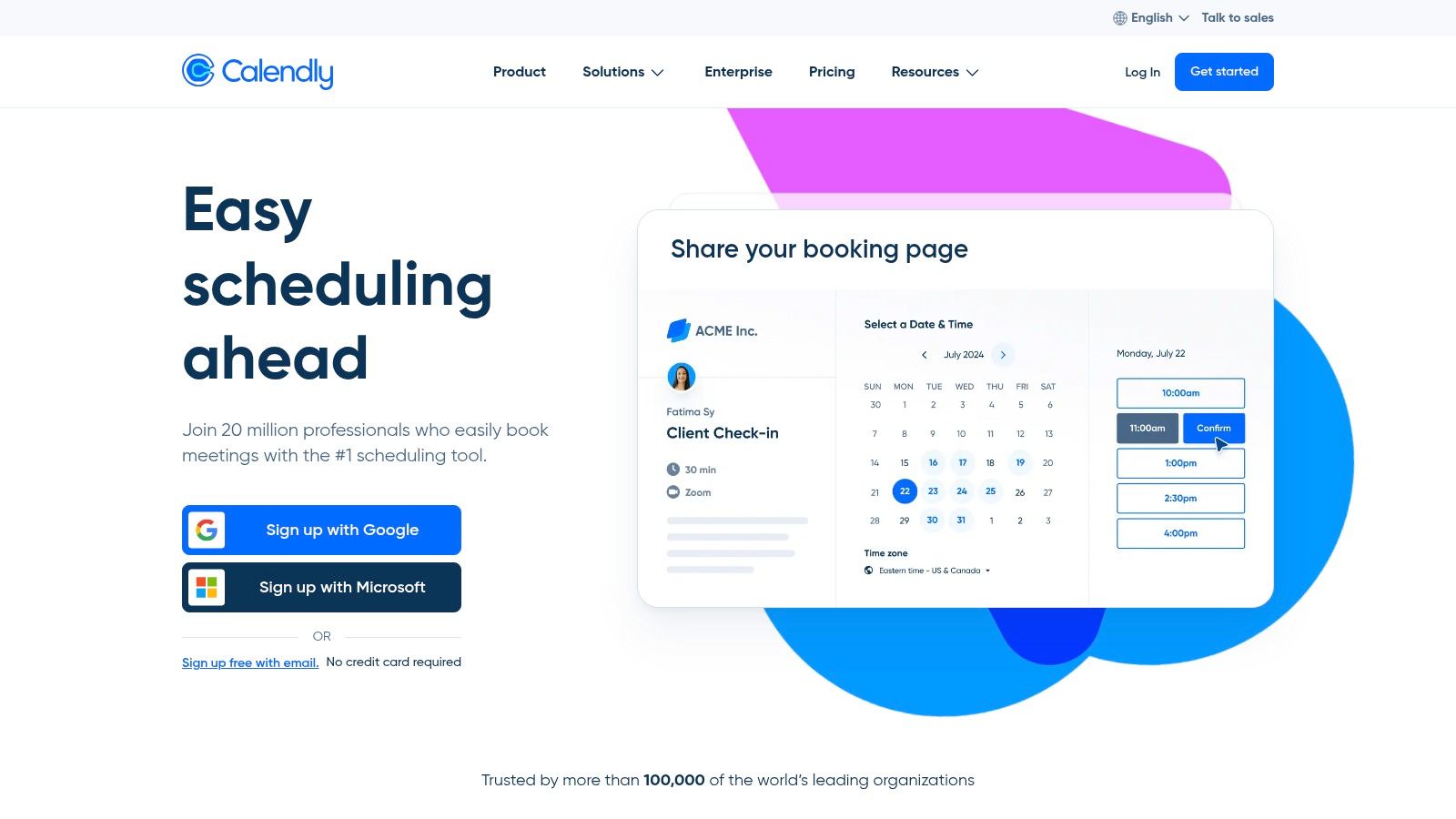
Calendly is a powerful scheduling tool that's perfect for managing appointments and meetings, especially in professional services. It works great for healthcare providers scheduling patient consultations, first responder organizations coordinating training, and any field requiring organized meeting management.
The platform makes scheduling effortless. Team members set their availability windows and get a personalized booking link to share. This removes the back-and-forth of emails and calls. The clean interface makes it easy for anyone to use, regardless of tech skills. It connects smoothly with Google Calendar, Outlook, and Apple Calendar to keep schedules in sync. You can also customize booking pages with your brand elements.
Key Features:
- Smart Scheduling: Takes the work out of coordinating meetings
- Calendar Sync: Works with major calendar platforms
- Team Scheduling: Shows when everyone is free
- Custom Pages: Match your brand look and feel
What's Great:
- Simple, clean interface
- Strong calendar integration
- User-friendly design
What Could Be Better:
- Basic shift scheduling abilities
- Not built for complex workforce management
- Limited options for time-off tracking
Cost: Basic features are free, with paid plans offering more options. See their website for current rates.
System Needs: Works in any web browser - no downloads needed.
How It Compares: While basic tools like When2meet focus on simple scheduling polls, Calendly offers more complete features for managing professional appointments. However, if you need full shift management, look at tools like Sling or Deputy instead.
Setup Tips:
- Set Clear Hours: Have team members carefully mark their available times
- Brand Your Pages: Add your logo and style to look professional
- Connect Calendars: Link with your team's existing calendar apps
Why We Recommend It:
Though not right for every business type, Calendly shines at simplifying appointment booking. It's especially good for healthcare providers, administrative teams, and training coordinators. The straightforward design makes it accessible for everyone. Just remember - if you need complex shift scheduling features, consider other options built specifically for workforce management.
Website: Calendly
8. Shiftboard
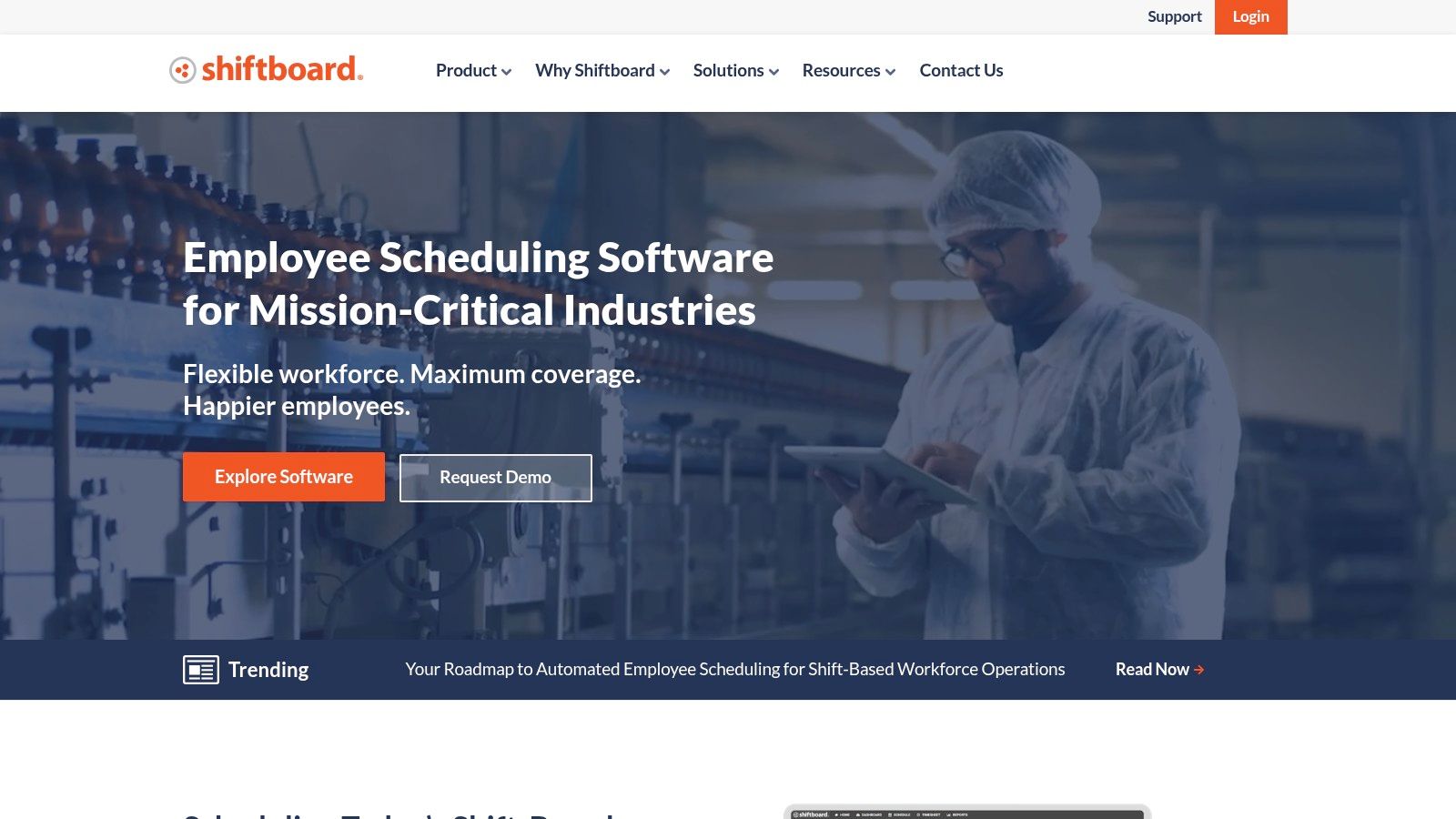
Shiftboard stands out for handling complex scheduling needs, especially in industries that need strict compliance tracking. Think large manufacturing plants managing rotating shifts, hospitals coordinating 24/7 coverage across departments, or security companies juggling multiple client sites. While smaller businesses might find it too robust, it shines when managing large-scale operations.
The software excels at coordinating intricate shift patterns while monitoring overtime and preventing staff burnout. For example, a manufacturing facility can automatically schedule workers across production lines while following union rules and safety regulations. In healthcare settings, it ensures proper nurse-to-patient ratios and manages physician on-call rotations while tracking required certifications.
Features:
- Advanced shift management: Handles complex schedules including rotating shifts and split shifts
- Compliance monitoring: Tracks certifications, licenses and regulatory requirements
- Overtime controls: Monitors hours, costs and compliance limits
- Staff wellbeing tools: Identifies potential fatigue risks from schedules
- Analytics: Provides detailed reports on labor costs and performance
Pros:
- Expert handling of complex scheduling scenarios
- Strong compliance features for regulated industries
- Comprehensive reporting capabilities
Cons:
- Interface takes time to learn due to many features
- Higher cost makes it better suited for larger organizations
Pricing: Contact Shiftboard directly for custom pricing based on your needs. The quote-based model reflects its enterprise-level capabilities.
Technical Requirements: As a cloud-based platform, Shiftboard runs in web browsers without needing special infrastructure.
Comparison: While tools like When I Work work well for basic scheduling, Shiftboard fits organizations needing advanced compliance tracking and shift pattern management.
Implementation Tips:
- Plan for training: Set aside adequate time to learn the system's capabilities
- Map out needs: Document your specific scheduling challenges and compliance requirements
- Use support resources: Take advantage of help documentation during setup
Website: https://www.shiftboard.com
For organizations with demanding staff scheduling needs, Shiftboard provides comprehensive solutions. Though potentially too complex and costly for small businesses, its advanced features make it ideal for industries like healthcare and manufacturing that require precise scheduling and compliance management.
9. QuickBooks Time (formerly TSheets)

QuickBooks Time, previously known as TSheets, stands out for its excellent integration with QuickBooks accounting software. This makes it an especially good fit for companies already using QuickBooks, as it simplifies payroll and invoicing workflows. While it offers reliable time tracking and scheduling features for many industries, its accounting integration is where it really shines.
For businesses in construction, manufacturing, and security where project costs matter most, the project time tracking feature proves invaluable. Teams can track hours for specific projects, giving clear data for billing clients and analyzing internal costs. The scheduling tools help retail and restaurant managers optimize staff levels and control costs. The mobile app with GPS tracking serves first responders, police, EMTs and military personnel who need accurate records while on the move. Picture a construction supervisor logging hours for different project phases right from the site, or a restaurant manager quickly adjusting schedules during a busy shift.
The core features include GPS time tracking, schedule management, full QuickBooks integration, and detailed project time tracking. The mobile app makes it simple for employees to log time and check schedules from anywhere - especially helpful for teams working in the field. The reporting tools provide key insights into employee hours and project progress.
Pros:
- Direct QuickBooks Integration: Time data syncs smoothly with QuickBooks for easy payroll and invoicing
- Full-Featured Mobile App: Staff can clock in/out, view schedules, and request time off on their phones
- Detailed Reports: Generates clear reports on employee hours, project time, and other key metrics
Cons:
- Higher Price Point: The cost may be challenging for smaller businesses or those not using QuickBooks
- Basic Scheduling Tools: The scheduling features are not as advanced as dedicated scheduling platforms. This could be limiting for complex scheduling needs.
You might be interested in: The Ultimate Guide to Clock In and Out Systems. This guide provides a complete overview of time tracking systems and options.
Website: QuickBooks Time Tracking
Implementation Tip: For QuickBooks users, setup is usually simple and straightforward. Review the support materials to ensure a smooth transition. If you don't use QuickBooks, weigh whether the integration benefits justify the higher cost compared to other options. Consider your industry needs and workforce requirements when deciding.
10. Planday
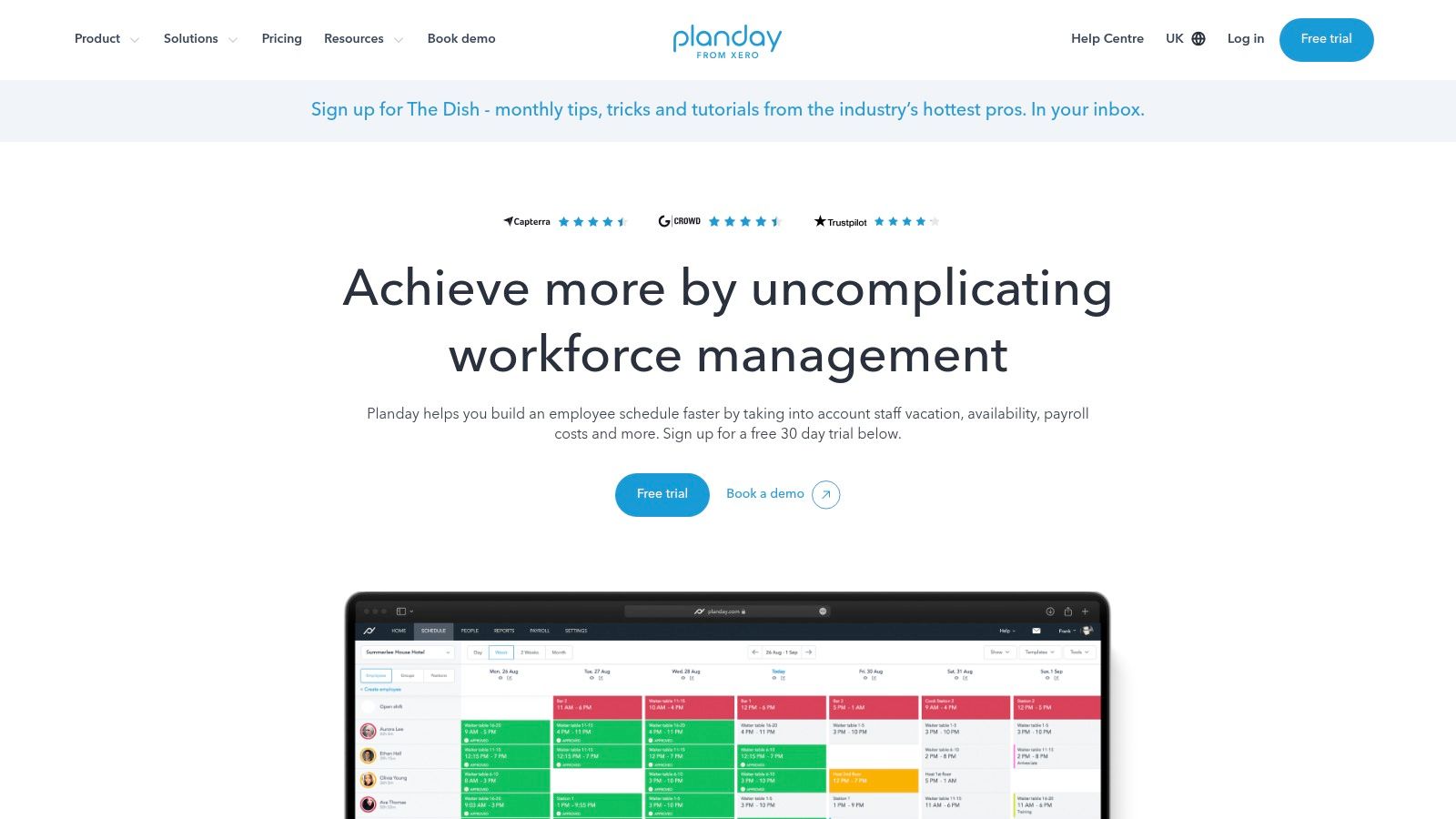
Planday stands out for teams that need solid scheduling and communication tools, especially in fields like retail, healthcare, security, and first responder services. The platform makes it easy to manage complex shift patterns while keeping teams connected.
At its core, Planday helps simplify shift management through features like self-service shift swapping. Team members can trade shifts on their own, which reduces admin work and adds flexibility. This is particularly helpful in healthcare settings where schedule changes happen often. For example, if a paramedic needs to switch shifts due to a personal emergency, they can quickly find a replacement while managers maintain oversight.
The built-in messaging system keeps everyone on the same page. Teams can share updates, announcements, and files directly in the app instead of juggling multiple communication tools. This creates a central hub for important information - perfect for emergency services teams that need to share critical updates quickly.
Planday also handles payroll calculations automatically based on completed shifts, which saves time processing payments. The reporting tools help managers track key data like labor costs and staff schedules. This helps organizations make smarter decisions about staffing levels and schedules.
Pros:
- Clear communication tools: Built-in messaging and file sharing keep teams connected
- Strong shift management: Easy shift swapping and schedule changes
- Simple interface: Quick to learn and start using
Cons:
- Short trial period: May need more time to fully test features
- Premium features cost more: Advanced reports and integrations require higher-tier plans
Pricing: Priced per employee per month. Contact Planday for specific rates based on team size and needed features.
Technical Requirements: Works through web browsers and mobile apps (iOS/Android).
Implementation Tips:
- Map out scheduling needs: Know your key requirements before getting started
- Use support resources: Take advantage of Planday's setup guides and help
- Train your team well: Make sure everyone knows how to use the key features
Comparison with alternatives: While other scheduling tools exist, Planday's focus on team communication and shift-based industries makes it especially good for first responders, healthcare workers, and security teams who need both flexible scheduling and reliable team coordination.
Website: Planday
Top 10 Employee Scheduling Apps: Head-to-Head Comparison
| Product | Core Features | UX | Value Proposition | Target Audience | USP |
|---|---|---|---|---|---|
| 🏆 Acroroster | Cloud-based scheduling, shift management, custom integration | ★★★★★ Intuitive | 💰 Enterprise support | 👥 Diverse industries (first responders, healthcare, etc.) | ✨ All-in-one integrated system |
| When I Work | Drag-and-drop builder, mobile clock-in, team messaging | ★★★★ User-friendly | 💰 Strong mobile & communication features | 👥 Businesses of all sizes | ✨ Effortless scheduling experience |
| Deputy | Auto-scheduling, labor optimization, compliance management | ★★★★ Comprehensive | 💰 Advanced reporting & integration | 👥 Medium to large enterprises | ✨ Robust compliance tools |
| 7shifts | Restaurant-specific scheduling, labor cost optimization | ★★★★ Industry-focused | 💰 Good value for restaurants | 👥 Food service & restaurant teams | ✨ Tailored restaurant integrations |
| Homebase | Free basic scheduling, time clock, HR tools | ★★★★ Simple & clear | 💰 Generous free plan | 👥 Small businesses | ✨ All-in-one employee management |
| Humanity | AI-powered auto-scheduling, forecasting, reporting | ★★★★ Powerful yet complex | 💰 Enterprise-grade features | 👥 Large organizations | ✨ Advanced automation capabilities |
| Calendly | Automated scheduling, calendar integration, booking pages | ★★★★ Clean & professional | 💰 Efficient appointment management | 👥 Professional services | ✨ Customizable team booking |
| Shiftboard | Complex shift patterns, compliance & overtime management | ★★★ Moderate usability | 💰 Comprehensive but premium | 👥 Manufacturing & healthcare | ✨ Designed for complex scenarios |
| QuickBooks Time | GPS time tracking, schedule management, QuickBooks sync | ★★★★ Strong mobile & integration | 💰 Ideal for accounting integration | 👥 QuickBooks users | ✨ Seamless QuickBooks connection |
| Planday | Shift swap management, payroll integration, communication | ★★★★ Clear and user-friendly | 💰 Focused retail/hospitality value | 👥 Retail & hospitality sectors | ✨ Robust communication tools |
Finding Your Perfect Scheduling Match
Selecting the right employee scheduling app is important when you have many good options like Acroroster, When I Work, Deputy, 7shifts, and others. The key is focusing on what your organization specifically needs. Think about your team size, scheduling complexity, and budget constraints. A small retail store has very different needs than a large hospital managing complex shift rotations.
Starting with a new scheduling system takes careful planning. First, identify what's not working with your current process. Get input from your team members who will use the system daily. Their feedback helps ensure you pick an app that solves real problems. Once you choose a solution, set aside proper time for training to help everyone transition smoothly.
Cost is a major factor to consider. While basic features may be free, most apps use tiered pricing based on team size and capabilities. Look closely at what features you get at each price level to find the best value. Remember to include costs for implementation support and ongoing maintenance in your budget planning.
Make sure any new app works well with your existing tools. Check if it connects to your payroll system, HR platform, and communication tools. Good integration reduces manual work and prevents errors. This is especially crucial for first responders, healthcare workers, and security teams who need reliable coordination. Whether you're scheduling for police, fire, EMT, restaurants, retail, manufacturing, construction or military - compatibility with your current systems matters.
Key points for choosing your scheduling app:
- Know Your Needs: List out your specific scheduling challenges and requirements
- Include Your Team: Get input from the people who will use it daily
- Review All Costs: Compare pricing tiers and total implementation expenses
- Check Integration: Verify it works with your existing business tools
Stop wasting time with manual scheduling headaches. Acroroster delivers scheduling tools that handle complex workforce management with ease. From custom database connections to enterprise support, Acroroster has what you need to optimize scheduling and improve efficiency.